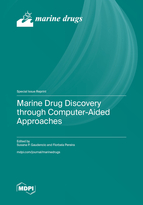Marine Drug Discovery through Computer-Aided Approaches
A special issue of Marine Drugs (ISSN 1660-3397).
Deadline for manuscript submissions: closed (31 December 2021) | Viewed by 33983
Special Issue Editors
Interests: marine natural products; structure elucidation; secondary metabolites; blue biotechnology; bioactive compounds from actinomycetes; drug discovery and biotechnological applications
Special Issues, Collections and Topics in MDPI journals
Interests: chemoinformatics; machine learning and data mining tecniques; quantitative structure–activity relationship (QSAR); quantitative structure–property relationship (QSPR); big data; DFT-calculated properties; marine natural products (MNP); virtual screening; nuclear magnetic resonance (NMR); dereplication; drug discovery
Special Issues, Collections and Topics in MDPI journals
Special Issue Information
Dear Colleagues,
Computer-Aided Ligand- and Structure-based methodologies are an evolving field in the discovery of Marine Drugs. Computational approaches and chemistry simulation methods, using bioinformatics and chemoinformatics tools, applications and databases, can be successfully used in the discovering, designing, and development of new chemical agents for therapeutic purposes, by assisting in the structure elucidation of secondary metabolites; repurposing known marine natural products (MNPs) for new therapeutic targets, identifying novel hits or leads against selected therapeutic targets, revealing mechanisms of action and supporting medicinal chemistry lead optimization programs.
This Special Issue of Marine Drugs entitled “Marine Drug Discovery through Computer-Aided Approaches” aims to provide a comprehensive overview of the great variety of existing and advanced Computer-Aided Approaches for the discovery and identification of molecular agents with added value and health-promoting properties for the development of biotechnological and medical applications.
As guest editors, we invite colleagues performing research on computer – aided drug discovery to contribute with your interesting papers to this Special Issue of Marine Drugs.
Dr. Susana P Gaudencio
Dr. Florbela Pereira
Guest Editors
Manuscript Submission Information
Manuscripts should be submitted online at www.mdpi.com by registering and logging in to this website. Once you are registered, click here to go to the submission form. Manuscripts can be submitted until the deadline. All submissions that pass pre-check are peer-reviewed. Accepted papers will be published continuously in the journal (as soon as accepted) and will be listed together on the special issue website. Research articles, review articles as well as short communications are invited. For planned papers, a title and short abstract (about 100 words) can be sent to the Editorial Office for announcement on this website.
Submitted manuscripts should not have been published previously, nor be under consideration for publication elsewhere (except conference proceedings papers). All manuscripts are thoroughly refereed through a single-blind peer-review process. A guide for authors and other relevant information for submission of manuscripts is available on the Instructions for Authors page. Marine Drugs is an international peer-reviewed open access monthly journal published by MDPI.
Please visit the Instructions for Authors page before submitting a manuscript. The Article Processing Charge (APC) for publication in this open access journal is 2900 CHF (Swiss Francs). Submitted papers should be well formatted and use good English. Authors may use MDPI's English editing service prior to publication or during author revisions.
Keywords
- Chemoinformatics
- Bioinformatics
- Dereplication
- Machine Learning Techniques
- MNPs Databases
- Chemical Space
- Biological Space
- Quantitative Structure–Activity Relationship (QSAR)
- Molecular Docking
- Computer-Aided Design Design (CADD)
- Computer–Assisted Structure Elucidation (CASE)
- Drug Discovery
- Drug repurposing








